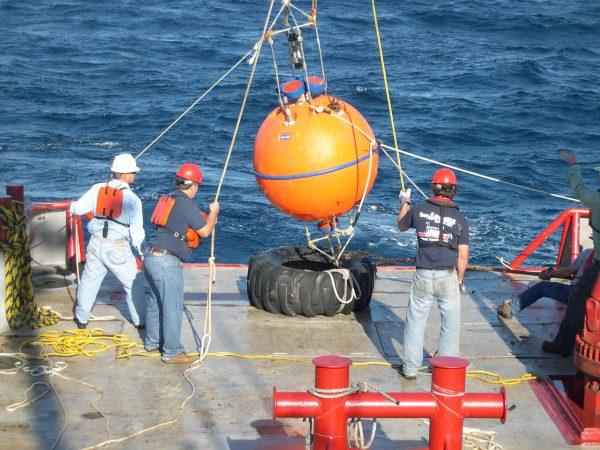For the next installment in our series of technical articles, ocean engineer Jon Wood addresses an interesting question related to deployment and recovery of subsea mooring systems. Jon has decades of experience working with DeepWater Buoyancy’s oceanographic buoys.
How Fast Does a Buoy Ascend?
I’ve been asked that question frequently, since the ascent (or descent) rate of a buoy can be a consideration when planning for offshore operations. Especially for projects in very deep water, it can take a long time for a mooring to reach the seabed, and an equally long, if not longer, time for it to float back to the surface. In this article we will look at the forces involved, methodology for tracking the rate during deployment or recovery, and an example that might help you estimate.
So, “How long will it take?” The true answer is, of course, “It depends!” It depends on the buoyancy of the buoys in the mooring and the weight of the line, instruments and anchor, as well as the drag forces imposed by all of the components.
We have measured these rates during several past mooring deployment and recovery operations. By setting a hydrophone over the rail and ranging repeatedly on the mooring’s acoustic releases (4 or 10 second repetition rate, typically), we have been able to quantify both descent (deployment) and ascent (recovery) speeds for different mooring configurations. Not all scenarios are the same but these data provide some ballpark estimates that may be helpful in planning future operations.
The two main factors that affect the descent rate of a mooring are the weight of the anchor (magnitude of the downward force) and the restraining effect of buoys and other mooring components (buoyancy and drag). Within these restraining effects, the largest components are typically buoys as they have the most immediate influence.
The mooring reaches terminal velocity when the downward gravitational force equals the upward restraining force. This seems to happen quickly once all components are submerged. Upon release, the ascent rates are also governed by the magnitude of the upward forces (i.e. buoyancy), as well as the drag-imposed restraints of all mooring components.
As an example, we had a mooring consisting of a 49” spherical buoy (reserve buoyancy about 900 lbs). The buoy was connected to the anchor via approximately 1000m of wire rope. The mooring also included two smaller (35” spherical) intermediate buoys plus assorted current meters. The anchor was a 4800-pound pile of old scrap chain cobbled together from a local salvage yard. After streaming out the mooring line from the vessel and free-falling the anchor (i.e. the anchor-last technique), the acoustic releases descended to the seabed at an average rate of about 3.0 meters/second. In 1500m water depth, that translates to 500 seconds, or just over 8 minutes, for the mooring to settle. On recovery, after the mooring was released from its anchor to float freely to the surface, we found the ascent rate was quite similar, about 2.8 meters/second. Since the top buoy was positioned roughly 500m deep, it took about 3 minutes for the buoy to appear at the surface.
Here’s wishing that your next mooring deployment sees a soft landing!
Jon Wood
Ocean Data Technologies, Inc.
About Ocean Data Technologies, Inc.
Ocean Data Technologies, Inc. is a Massachusetts (United States) corporation providing oceanographic data acquisition services and support to the global offshore marine industry. Ocean Data designs and installs simple, reliable systems that collect information critical to our customer’s needs in deep-water, continental shelf, as well as nearshore and estuary regions.
Contact us at www.oceandatatech.com
About DeepWater Buoyancy, Inc.
DeepWater Buoyancy creates subsea buoyancy products for leading companies in the oceanographic, seismic, survey, military and offshore oil & gas markets. Customers have relied on our products for over thirty-five years, from the ocean surface to depths exceeding six thousand meters.
Contact us at www.DeepWaterBuoyancy.com

Ocean Data Technologies recovering a spherical ADCP buoy 8 miles outside of Port Everglades, Florida, in the Florida Current (Gulf Stream), aboard the M/V Richard L. Becker. The ADCP mooring was for Dr. Alexander Soloviev of Nova Southeastern University. It was deployed for nearly 4 years, with regular 6-month turnaround operations (like this one), recording an impressive data set of Gulf Stream variability.

